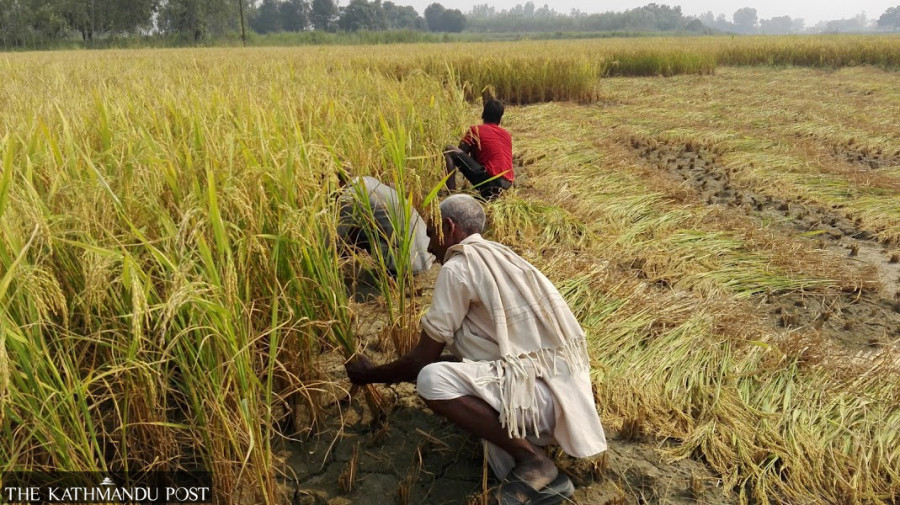Money
Drought and heat wave take toll on paddy crop
Nepal's harvest in the fiscal year 2022-23 is doubtful due to a combination of climatic and man-made factors, experts say.
Rupa Gahatraj
Ram Naresh Yadav of Narainapur in Banke says his granary is almost empty, but the paddy harvest is two months away.
Rice is Nepal’s most important crop and the primary source of livelihood for more than two-thirds of farm households. It is transplanted in June-July and harvested in November.
Yadav, who lives in the Tarai flatlands in south-western Nepal, said the drought in August shrivelled his paddy crop. He doesn't think he will be able to fill his granary with this year's harvest.
"The rain did not fall. Paddy saplings dried in the fields," said the 55-year-old Yadav.
His four-member family is entirely dependent on farming to survive. "This year, it seems I will have to struggle to pay for my family’s daily needs."
Experts say Nepal's harvest in the fiscal year 2022-23 is doubtful due to a combination of climatic and man-made factors.
The farming outlook in many countries is also pessimistic due to the August heat waves. With India and other food-producing countries imposing export bans, poor countries like Nepal could be in for a hard time because many could face food shortages or prices could go up sharply.
In Nepal, most of the farmers in the southern Tarai belt, the country's food basket, faced a shortage of chemical fertiliser in the June-July paddy transplantation period, and were subsequently hit by a drought-like situation.
The heat wave that appeared in August added to their woes.
The government had promised that fertiliser would be available in August after India started sending shipments through a government-to-government deal. But that did not happen.
"From fertiliser to the climate, we are suffering from problems all around," said Yadav. “Luck doesn’t seem to favour farmers.”
Dildar Husain, another farmer in Narainapur, said half of his 1-bigha farm was inundated by floods. He had transplanted paddy on 7 katthas. "The paddy saplings on 7 katthas too dried up,” said Husain.
He is trying to grow another crop on the same land. "The labour, time and money I spent on the farm this year yielded no results. It’s gone."
Husain said that he could not earn enough money to provide for his family this year. Last year too, the October flood had swept away his ready-to-harvest paddy. "Farm work is difficult. I have planned to go abroad to work and earn more money," Hussain told the Post.
Rama Abhir Ali had to resort to boring five times to irrigate her 21-kattha farm after drought hit the entire Narainapur area. According to her, she used 35 litres of diesel to pump water out of the ground to irrigate her parched fields.
“It’s an extra cost,” she said. “It has become difficult for me to pay the loans taken to irrigate the land,” she said. Her harvest doesn’t seem promising either.
Ali laments that the government did not pay compensation for her crop losses last October.
Last year, ready-to-harvest paddy crops on 85,580 hectares were swept away or submerged by unseasonal floodwaters in all seven provinces.
The Agriculture Ministry's report said that 325,258 tonnes of paddy worth around Rs8.26 billion was destroyed.
"We have been suffering every year," said Ali. "Now, I am planning to travel to India to earn money."
Most of the people in Narainapur are dependent on farming. Farmlands cover 4,200 hectares of the rural municipality. Farmers transplanted paddy on only 15 percent of the fields due to water scarcity.
The rural municipality has declared Narainapur a drought-affected area after the transplanted paddy too started to wither.
As the weather did not support the farmers this year, many have planned to go abroad for work.
Narainapur Rural Municipality Chairman Istiyak Ahmed Sah says he has been appealing for support from the federal and provincial governments.
"As the groundwater has not been recharged, there is a problem for groundwater irrigation facility too," said Sah. "We are making every effort to provide compensation to the drought-hit farmers."
Bharat Basnet, chief administration officer of Narainapur Rural Municipality, said, "The local government has decided to give an 80 percent discount on the land tax."
He said, "Similarly, we have decided to provide deep boring and other alternative irrigation facilities, provide diesel at subsidised rates and launch an agriculture programme under which the electricity used for farming purposes will be provided free."
Climate change this year has defied forecasts by South Asian meteorologists.
According to a consensus statement released by the 22nd Session of the South Asian Climate Outlook Forum in April-end, Nepal was expected to receive above-normal monsoon rains this year.
The government had announced in the budget statement that cereal production would increase by 30 percent from 10 million tonnes to 14 million tonnes this fiscal year.
Experts immediately called it one of the greatest ironies because the country is facing a severe shortage of chemical fertilisers without which crops cannot grow. In August, farmers were hit by drought and then there was a heat wave.




 6.12°C Kathmandu
6.12°C Kathmandu













%20(1).jpg&w=300&height=200)
